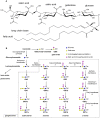Ganglioside Profiling of the Human Retina: Comparison with Other Ocular Structures, Brain and Plasma Reveals Tissue Specificities
- PMID: 27997589
- PMCID: PMC5173345
- DOI: 10.1371/journal.pone.0168794
Ganglioside Profiling of the Human Retina: Comparison with Other Ocular Structures, Brain and Plasma Reveals Tissue Specificities
Abstract
Gangliosides make a wide family of glycosphingolipids, highly heterogeneous in both the ceramide moiety and the oligosaccharide chain. While ubiquitously expressed in mammalian tissues, they are particularly abundant in the brain and the peripheral nervous system. Gangliosides are known to play a crucial role in the development, maintenance and functional integrity of the nervous system. However, the expression and roles of gangliosides in the retina, although often considered as a window on the brain, has been far less studied. We performed an in-depth analysis of gangliosides of the human retina, especially using powerful LC/MS methods. We compared the pattern of ganglioside classes and ceramide molecular species of this tissue with other ocular structures and with brain and plasma in elderly human individuals. About a hundred of ganglioside molecular species among 15 distinct classes were detected illustrating the huge structural diversity of these compounds. The retina exhibited a very diverse ganglioside profile and shared several common features with the brain (prominence of tetraosylgangliosides, abundance of d20:1 long chain base and 18:0 fatty acid…). However, the retina stood out with the specific expression of GD3, GT3 and AcGT3, which further presented a peculiar molecular species distribution. The unique ganglioside pattern we observed in the human retina suggests that these ganglioside species play a specific role in the structure and function of this tissue. This lipidomic study, by highlighting retina specific ganglioside species, opens up novel research directions for a better understanding of the biological role of gangliosides in the retina.
Conflict of interest statement
The authors have declared that no competing interests exist.
Figures





Similar articles
-
Apprehending ganglioside diversity: a comprehensive methodological approach.J Lipid Res. 2015 Sep;56(9):1821-35. doi: 10.1194/jlr.D060764. Epub 2015 Jul 4. J Lipid Res. 2015. PMID: 26142958 Free PMC article.
-
Plasmatic Ganglioside Profile and Age-Related Macular Degeneration: A Case-Control Study.Ophthalmic Res. 2016;56(1):41-8. doi: 10.1159/000444059. Epub 2016 Apr 2. Ophthalmic Res. 2016. PMID: 27035458
-
Aberrant ganglioside composition in glioblastoma multiforme and peritumoral tissue: A mass spectrometry characterization.Biochimie. 2017 Jun;137:56-68. doi: 10.1016/j.biochi.2017.03.001. Epub 2017 Mar 10. Biochimie. 2017. PMID: 28286312
-
Neurological analyses: focus on gangliosides and mass spectrometry.Adv Exp Med Biol. 2014;806:153-204. doi: 10.1007/978-3-319-06068-2_8. Adv Exp Med Biol. 2014. PMID: 24952183 Review.
-
Salvage pathways in glycosphingolipid metabolism.Biochimie. 2003 Mar-Apr;85(3-4):423-37. doi: 10.1016/s0300-9084(03)00047-6. Biochimie. 2003. PMID: 12770781 Review.
Cited by
-
Don't Be Surprised When These Surprise You: Some Infrequently Studied Sphingoid Bases, Metabolites, and Factors That Should Be Kept in Mind During Sphingolipidomic Studies.Int J Mol Sci. 2025 Jan 14;26(2):650. doi: 10.3390/ijms26020650. Int J Mol Sci. 2025. PMID: 39859363 Free PMC article. Review.
-
Biology of GD2 ganglioside: implications for cancer immunotherapy.Front Pharmacol. 2023 Aug 21;14:1249929. doi: 10.3389/fphar.2023.1249929. eCollection 2023. Front Pharmacol. 2023. PMID: 37670947 Free PMC article. Review.
-
Fish Nutritional Value as an Approach to Children's Nutrition.Front Nutr. 2021 Dec 15;8:780844. doi: 10.3389/fnut.2021.780844. eCollection 2021. Front Nutr. 2021. PMID: 34977125 Free PMC article. Review.
-
Preparing glycomics data for robust statistical analysis with GlyCompareCT.STAR Protoc. 2023 Mar 13;4(2):102162. doi: 10.1016/j.xpro.2023.102162. Online ahead of print. STAR Protoc. 2023. PMID: 36920914 Free PMC article.
-
Correcting for sparsity and interdependence in glycomics by accounting for glycan biosynthesis.Nat Commun. 2021 Aug 17;12(1):4988. doi: 10.1038/s41467-021-25183-5. Nat Commun. 2021. PMID: 34404781 Free PMC article.
References
-
- Svennerholm L. Ganglioside designation. Adv Exp Med Biol. 1980;125:11 - PubMed
-
- Yu RK, Yanagisawa M., Ariga T.. Glycosphingolipid Structures In: Kamerling JP, editor. Comprehensive Glycoscience. 1: Elsevier; 2007. p. 73–120.
MeSH terms
Substances
LinkOut - more resources
Full Text Sources
Other Literature Sources

